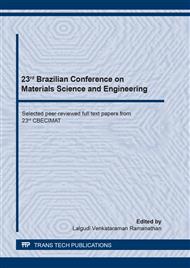p.250
p.256
p.262
p.268
p.272
p.278
p.284
p.291
p.296
The Use of Thermogravimetric Analysis to Characterize the Metallic Slag Aggregates in Structural Concrete
Abstract:
Structural concretes must have a set of chemical characteristics to present a satisfactory resistance to the degradation in environment conditions. Besides the several types of mineralogical compositions, the calcium-rich sulfates, silicates and aluminates phases appear as majority components, but the gypsum one seems to play the most important rule in morphological changes during the concrete cure. In this work, it was carried out several characterizations in commercial Portland cement and the structural concrete sample. Nitrogen adsorption isotherms at 77 K for Portland cement showed the thermal treatment at 500 oC does not undergo significant decreasing in surface area due the high content of porous silicates and aluminates components. The additional resistance to the corrosion of structural concretes exposed at environment conditions can be associated to presence of slag metallic aggregates, which could be characterized successfully by thermal analysis. The amount of embedded metallic component in concrete sample was detected by typical weight gain originated form oxygen incorporation above 700 oC.
Info:
Periodical:
Pages:
272-277
Citation:
Online since:
October 2020
Price:
Сopyright:
© 2020 Trans Tech Publications Ltd. All Rights Reserved
Share:
Citation:


